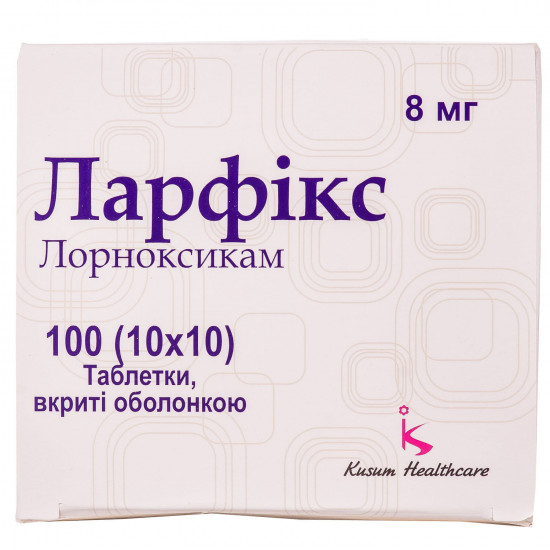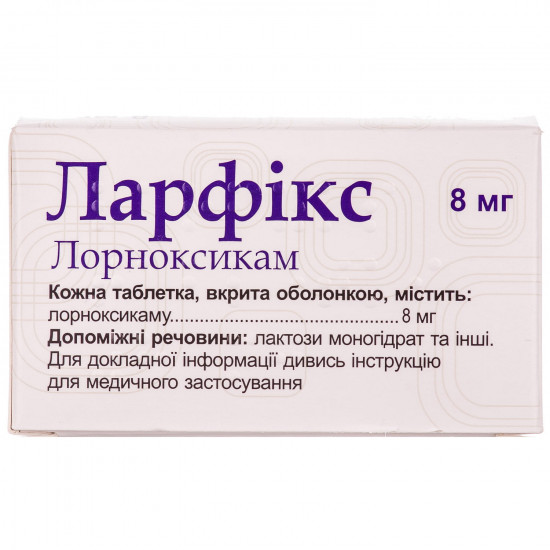



- Stock: In Stock
- Model: 183650
0% Customers recommend this product
-
5 Awesome0%
-
4 Great0%
-
3 Average0%
-
2 Bad0%
-
1 Poor0%
Reviews Over Larfix tab. of p/o of 8 mg No. 100
- (0)
Total Reviews (0)
click here write review to add review for this product.
Report this review.
Description
Lornoksikam is NPVP (NPVS) with anesthetic and anti-inflammatory properties and belongs to the class of oksikam.
Indication
Short-term treatment of an acute pain of easy and moderate degree.
Symptomatic pain relief and inflammations in an osteoarthritis.
Symptomatic pain relief and inflammations in a pseudorheumatism.
Contraindication
- Hypersensitivity to a lornoksikam or to medicament components.
- Thrombocytopenia.
- Hypersensitivity (symptoms, similar as in asthma, rhinitis, angioneurotic hypostasis or a small tortoiseshell) in other NPVS, including acetylsalicylic acid.
- Severe form of heart failure.
- Gastrointestinal bleedings, cerebral and vascular bleedings or other disturbances of blood clotting.
- Gastrointestinal bleeding or perforation of an ulcer in the anamnesis connected with the previous therapy of NPVP.
- Sharp or recuring chronic stomach ulcer / bleeding in the anamnesis (two or more separate proved episodes of developing of an ulcer or bleeding).
- Severe form of a liver failure.
- Severe form of a renal failure (level of serumal creatinine> 700 µmol/l).
- III pregnancy trimester.
Structure
active ingredient: lornoxicam; 1 tablet contains 4 mg or 8 mg of a lornoksikam;
excipients: lactose, cellulose microcrystalline, povidone, sodium of a kroskarmelloz, magnesium stearate, Opadry white 03F58750 *.
* Opadry white 03F58750: talc, polyethyleneglycol, hydroksipropilmetiltsellyuloz, titan dioxide (E 171).
Interaction with other medicines and other types of interactions
As food slows down absorption of a lornoksikam, a pill of Larfix should not be taken with food in case of need of quick start of their effective action (pain relief).
Meal reduces absorption approximately by 20% and increases T max.
toUse during pregnancy and feeding by a breast
toLornoksikam is contraindicated to
Feature of use
in the III trimester of pregnancy. Clinical data on use to a lonoksikam in the I-II trimesters of pregnancy and during childbirth not therefore medicament is not recommended to be used during this period. do not havesufficient data concerning use of a lornoksikam to pregnant women. Researches on animals showed to reproductive toxicity.
Oppression of synthesis of prostaglandins can negatively affect pregnancy and/or development of an embryo / fruit. Data of epidemiological researches confirm increase in risk of a miscarriage of pregnancy and also development of heart diseases at use of inhibitors of synthesis of prostaglandins in the early stages of pregnancy. The risk increases at increase in a dose and duration of therapy. At animals of use of inhibitors of synthesis of prostaglandins leads to increase pre- and postimplantatsiyno of death of a fruit and embrio-fetal lethality. Inhibitors of synthesis of prostaglandins should not be applied in the I and II trimesters of pregnancy. Use is possible only at emergency.
On III trimesters of pregnancy at use of any inhibitors of synthesis of prostaglandins the following impacts on a fruit are possible:
- cardiopulmonary toxicity (premature closing of an arterial channel and pulmonary hypertensia)
- a renal failure which can progress to a renal failure, and then to reduction of amount of amniotic waters.
Pregnant and a fruit at the end of pregnancy can undergo such influences from use of inhibitors of synthesis of prostaglandins:
increase in duration of bleedings is possible- ;
- oppression of sokratitelny function of a uterus that can lead to a delay or increase in a duration of delivery.
Thus, use of a lornoksikam is contraindicated on III trimesters of pregnancy.
feeding Period a breast
Is not present data on excretion of a lornoksikam in human breast milk. Rather high concentrations of a lornoksikam are excreted with milk of the feeding rats. Therefore lornoksika should not apply during feeding by a breast.
ChildrenLornoksikam is not recommended to apply
to children up to 18 years in connection with insufficiency of data on efficiency and safety of use of drug. Ability to influence speed of response at control of motor transport or other mechanisms
in case of developing of dizziness and/or drowsiness owing to administration of medicament should not run motor transport or to work with other mechanisms.
Route of administration and doses
to take Tabletki Larfix orally, washing down with enough water.
For all patients the corresponding mode of dosing has to be based on individual the response to treatment.
Pain
Dose of 8-16 mg of a lornoksikam a day divided into 2-3 receptions. The maximum recommended daily dose makes 16 mg.
Osteoarthritis and a pseudorheumatism Is recommended toby
initial dose of 12 mg of a lornoksikam divided into 2-3 receptions.
Maintenance dose should not exceed 16 mg a day.
OverdoseNow data on overdose which would allow to define its consequences or to offer
specific treatment, no. Symptoms
Can be observed by
such symptoms as nausea, vomiting, cerebral symptoms (dizziness, a disorder of vision). In hard cases: an ataxy, with transition to a coma and spasms of damage of a liver and kidneys; fibrillation disturbance is possible.
Treatment
At available or expected to overdose should stop medicament use. Thanks to short elimination half-life to lornoksika it is quickly brought out of an organism. Dialysis does not give in. There is no specific antidote now. It is necessary to carry out usual urgent measures, including gastric lavage. Use of activated carbon at its reception right after overdose of a lornoksikam can lead to medicament absorption reduction. For treatment of gastrointestinal disorders it is possible to use an analog of prostaglandin or ranitidine, for example.
Side reactionsMost often side reactions of NPVP were connected by
with digestive tract. At reception of NPVP there can be round ulcers, perforation or gastrointestinal bleeding, sometimes comes to an end letalno, especially at elderly people. Nausea, vomiting, diarrhea, a meteorism, a constipation, dyspepsia, an abdominal pain, ground, vomiting by blood, a stomacace, exacerbation of colitis and Crohn's disease were registered at treatment of NPVP. Gastritises were less often observed.
It is considered p that approximately 20% of patients who were treated a lornoksikama can have by-effects. The most frequent by-effects of a lornoksikam are nausea, dyspepsia, a digestive disturbance, an abdominal pain, vomiting, diarrhea. These symptoms in general were observed less than in 10% of the patients participating in a research. Hypostases, arterial hypertension and heart failure were registered at treatment of NPVP.
clinical and epidemiological data which show that use of some NPVP, especially in high doses and at long reception can be connected with increase in risk of the arterial trombotichesky phenomena, for example, a myocardial infarction or a stroke Exist.
Storage conditionsto Store
at a temperature not above 25 °C out of children's reach.
Expiration date - 2 years.
Specifications
| Characteristics | |
| Active ingredients | Lornoksikam |
| Amount of active ingredient | 8 mg |
| Applicant | Kusum Healthcare |
| Code of automatic telephone exchange | M01AC05 Lornoksikam |
| Interaction with food | It doesn't matter |
| Light sensitivity | Not sensitive |
| Market status | The branded generic |
| Origin | Chemical |
| Prescription status | According to the prescription |
| Primary packing | blister |
| Producer | KUSUM HELTKHKER PVT LTD |
| Quantity in packing | 100 tablets (10 blisters on 10 pieces) |
| Release form | tablets for internal use |
| Route of administration | Oral |
| Sign | Import |
| Storage temperature | from 5 °C to 25 °C |
| Trade name | Larfix |














































